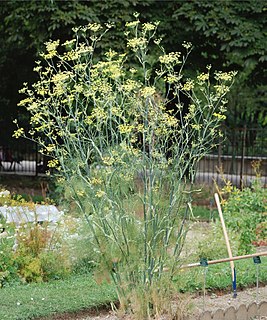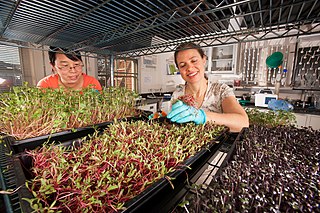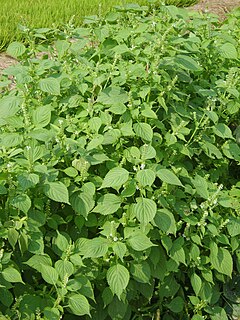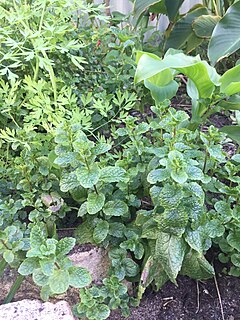Related Research Articles

Mentha is a genus of plants in the family Lamiaceae. The exact distinction between species is unclear; it is estimated that 13 to 24 species exist. Hybridization occurs naturally where some species' ranges overlap. Many hybrids and cultivars are known.

The turnip or white turnip is a root vegetable commonly grown in temperate climates worldwide for its white, fleshy taproot. The word turnip is a compound of turn as in turned/rounded on a lathe and neep, derived from Latin napus, the word for the plant. Small, tender varieties are grown for human consumption, while larger varieties are grown as feed for livestock. In the north of England, Scotland, Ireland, Cornwall and parts of Canada, the word turnip often refers to rutabaga, also known as swede, a larger, yellow root vegetable in the same genus (Brassica).

Caraway, also known as meridian fennel and Persian cumin, is a biennial plant in the family Apiaceae, native to western Asia, Europe, and North Africa.

Fennel is a flowering plant species in the carrot family. It is a hardy, perennial herb with yellow flowers and feathery leaves. It is indigenous to the shores of the Mediterranean but has become widely naturalized in many parts of the world, especially on dry soils near the sea-coast and on riverbanks.

Basil, also called great basil, is a culinary herb of the family Lamiaceae (mints). It is a tender plant, and is used in cuisines worldwide. In Western cuisine, the generic term "basil" refers to the variety also known as sweet basil or Genovese basil. Basil is native to tropical regions from Central Africa to Southeast Asia. In temperate climates basil is treated as an annual plant, however, basil can be grown as a short-lived perennial or biennial in warmer horticultural zones with tropical or Mediterranean climates.

The curry tree, Murraya koenigii or Bergera koenigii, is a tropical to sub-tropical tree in the family Rutaceae, and is native to Asia. The plant is also sometimes called sweet neem, though M. koenigii is in a different family to neem, Azadirachta indica, which is in the related family Meliaceae.

Assam tea is a black tea named after the region of its production, Assam, India. It is manufactured specifically from the plant Camellia sinensis var. assamica (Masters). The Assam tea plant is indigenous to Assam—initial efforts to plant the Chinese varieties in Assam soil did not succeed. Assam tea is now mostly grown at or near sea level and is known for its body, briskness, malty flavour, and strong, bright colour. Assam teas, or blends containing Assam, are often sold as "breakfast" teas. For instance, Irish breakfast tea, a maltier and stronger breakfast tea, consists of small-sized Assam tea leaves.

Ocimenes are a group of isomeric hydrocarbons. The ocimenes are monoterpenes found within a variety of plants and fruits. α-Ocimene and the two β-ocimenes differ in the position of the isolated double bond: it is terminal in the alpha isomer. α-Ocimene is cis-3,7-dimethyl-1,3,7-octatriene. β-Ocimene is trans-3,7-dimethyl-1,3,6-octatriene. β-Ocimene exists in two stereoisomeric forms, cis and trans, with respect to the central double bond. The ocimenes are often found naturally as mixtures of the various forms. The mixture, as well as the pure compounds, are oils with a pleasant odor. They are used in perfumery for their sweet herbal scent, and are believed to act as plant defense and have anti-fungal properties. Like the related acyclic terpene myrcene, ocimenes are unstable in air. Like other terpenes, the ocimenes are nearly insoluble in water, but soluble in common organic solvents.

Thai basil called káu-chàn-thah in Taiwan, is a type of basil native to Southeast Asia that has been cultivated to provide distinctive traits. Widely used throughout Southeast Asia, its flavor, described as anise- and licorice-like and slightly spicy, is more stable under high or extended cooking temperatures than that of sweet basil. Thai basil has small, narrow leaves, purple stems, and pink-purple flowers.

Lemon basil, hoary basil, Thai lemon basil, or Lao basil, is a hybrid between basil and American basil. The herb is grown primarily in northeastern Africa and southern Asia for its fragrant lemon scent, and is used in cooking.

Bún bò Huế or bún bò is a popular Vietnamese rice noodle (bún) dish with sliced beef (bò), chả lụa, and sometimes pork knuckles. The dish originates from Huế, a city in central Vietnam associated with the cooking style of the former royal court. The dish has a mix of spicy, salty, and umami flavors. The predominant flavor is that of lemongrass. Compared to phở or bún riêu, the noodles are thicker and cylindrical.

Microgreens are vegetable greens harvested just after the cotyledon leaves have developed. They are used as a nutrition supplement, a visual enhancement, and a flavor and texture enhancement. Microgreens can add sweetness and spiciness to foods. Microgreens are smaller than “baby greens” because they are harvested very soon after sprouting, rather than after the plant has matured to produce multiple leaves. Among upscale grocers, they are now considered a speciality genre of greens, good for garnishing salads, soups, sandwiches, and plates. They can be used as a main vegetable as well in certain recipes for intense flavor and nutrition. Many recipes use them as a garnish while some utilize them as the main ingredient. For example, garlic pea shoots, pea shoots or micro cabbage in cabbage soup, or coleslaw made with radish microgreen instead of cabbage. As microgreens become more popular for their intense flavor and nutrition, innovative chefs and cooks create new ways to use them.

African blue basil is a hybrid basil variety, a cross between camphor basil and dark opal basil. It is one of a few types of basil that are perennial. African blue basil plants are sterile, unable to produce seeds of their own, and can only be propagated by cuttings.

Perilla frutescens, commonly called deulkkae, perilla or Korean perilla, is a species of Perilla in the mint family Lamiaceae. It is an annual plant native to Southeast Asia and Indian highlands, and is traditionally grown in the Korean peninsula, southern China, Japan and India as a crop.

Cinnamon basil is a type of basil. The term "cinnamon basil" can refer to a number of different varieties of basil, including as a synonym for Thai basil, as a particular cultivar of Thai basil, and as a separate cultivar in its own right. This article discusses the latter type.
Mrs. Burns' Lemon basil is an heirloom cultivar of sweet basil from New Mexico in the United States. Compared to lemon basil, which is a different species of basil, in Mrs. Burns lemon basil the lemon flavor is more intense, the leaves are larger, and the plant itself is more robust.
Fino verde basil is a cultivar of Ocimum basilicum. Some sources list Fino verde as a synonym for spicy globe basil, while others list it as a separate variety. Fino verde grows as a small, dense bush, suitable for gardening or pots. The leaves are much smaller than those of most basils. The flavor is similar to that of sweet basil, but stronger and spicier. The leaves are easy to use in cooking because they can be used twigs and all, unlike basils with larger leaves.

The tomato is the edible berry of the plant Solanum lycopersicum, commonly known as a tomato plant. The species originated in western South America and Central America. The Mexican Nahuatl word tomatl gave rise to the Spanish word tomate, from which the English word tomato derived. Its domestication and use as a cultivated food may have originated with the indigenous peoples of Mexico. The Aztecs used tomatoes in their cooking at the time of the Spanish conquest of the Aztec Empire, and after the Spanish encountered the tomato for the first time after their contact with the Aztecs, they brought the plant to Europe, in a widespread transfer of plants known as the Columbian exchange. From there, the tomato was introduced to other parts of the European-colonized world during the 16th century.

In general use, herbs are a widely distributed and widespread group of plants, excluding vegetables and other plants consumed for macronutrients, with savory or aromatic properties that are used for flavoring and garnishing food, for medicinal purposes, or for fragrances. Culinary use typically distinguishes herbs from spices. Herbs generally refers to the leafy green or flowering parts of a plant, while spices are usually dried and produced from other parts of the plant, including seeds, bark, roots and fruits.

Greek basil is a flowering herb and cultivar of basil.
References
- ↑ "Growing annual basils". The Tasteful Garden. Archived from the original on 2011-07-16. Retrieved 2007-01-05.